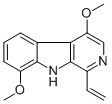Home
Products
Dehydrocrenatidine



| Product Name | Dehydrocrenatidine |
| Price: | Inquiry |
| Catalog No.: | CN01671 |
| CAS No.: | 65236-62-6 |
| Molecular Formula: | C15H14N2O2 |
| Molecular Weight: | 254.3 g/mol |
| Purity: | >=98% |
| Type of Compound: | Alkaloids |
| Physical Desc.: | Yellow powder |
| Source: | The barks of Picrasma quassioides |
| Solvent: | Chloroform, Dichloromethane, Ethyl Acetate, DMSO, Acetone, etc. |
| SMILES: |
| Contact us | |
|---|---|
| First Name: | |
| Last Name: | |
| E-mail: | |
| Question: | |
| Description | Dehydrocrenatidine, a natural alkaloid, is a specific JAK inhibitor. Dehydrocrenatidine inhibits voltage-gated sodium channels and ameliorates mechanic allodia in a rat model of neuropathic pain[1][2]. |
| In Vitro | Dehydrocrenatidine inhibits JAK-STAT3 dependent DU145 and MDA-MB-468 cell survival and induces cell apoptosis. Dehydrocrenatidine inhibits JAKs-JH1 domain over-expression induced STAT3 and STAT1 phosphorylations[1]. Dehydrocrenatidine diminishes IL-6, IFNα and IFNγ stimulated STAT3 phosphorylation as well as constitutive STAT3 phosphorylation[1]. DHCT suppresses both tetrodotoxin-resistant (TTX-R) and sensitive (TTX-S) voltage-gated sodium channel (VGSC) currents with IC50 values of 12.36 µM and 4.87 µM, respectively[2]. |
| In Vivo | Dehydrocrenatidine inhibits JAK-STAT3 dependent DU145 and MDA-MB-468 cell survival and induces cell apoptosis. Dehydrocrenatidine inhibits JAKs-JH1 domain over-expression induced STAT3 and STAT1 phosphorylations[1]. Dehydrocrenatidine diminishes IL-6, IFNα and IFNγ stimulated STAT3 phosphorylation as well as constitutive STAT3 phosphorylation[1]. DHCT suppresses both tetrodotoxin-resistant (TTX-R) and sensitive (TTX-S) voltage-gated sodium channel (VGSC) currents with IC50 values of 12.36 µM and 4.87 µM, respectively[2]. |
| Density | 1.3±0.1 g/cm3 |
| Boiling Point | 491.8±40.0 °C at 760 mmHg |
| Flash Point | 174.9±17.6 °C |
| Exact Mass | 254.105530 |
| PSA | 47.14000 |
| LogP | 3.70 |
| Vapour Pressure | 0.0±1.2 mmHg at 25°C |